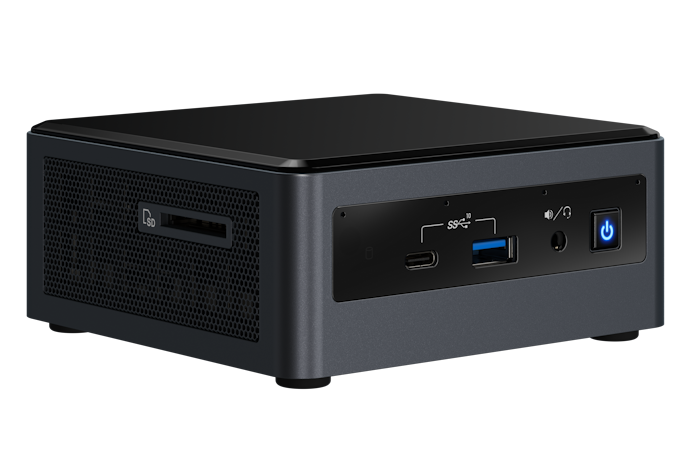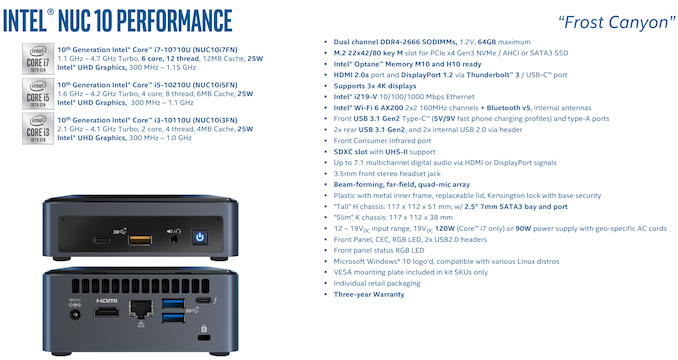Intel NUC10i7FNH Frost Canyon Review: Hexa-Core NUC Delivers a Mixed Bag
by Ganesh T S on March 2, 2020 9:00 AM ESTConcluding Remarks
The NUC10i7FNH is the latest in the line-up of mainstream NUCs from Intel. Long a niche market that Intel has dominated both directly and indirectly via its own NUCs as well as its low-TDP processors, compared where things stood a few years back, consumers these days have a number of alternatives to the mainstream NUCs. We are not referring only to the NUC clones using Intel's U-series processors, but, also the new crop of Ryzen-based UCFF PCs. The new competition means that Intel has to deliver a package that delivers more value for money compared to previous NUC offerings.
While reviewing the Bean Canyon NUC, we had indicated that it was a compact powerhouse ticking the right boxes for multiple use-cases. The tangible benefit delivered by the 'NUC8' over its predecessor was the upgrading of all the external USB ports to USB 3.2 Gen 2 (10 Gbps), and the inclusion of a more powerful Wireless-AC 9560 WLAN component. Similarly, the Frost Canyon NUC10 carries over some of the important features and also provides some welcome upgrades:
- The top-level configuration with the Core i7-10710U is a 6C/12T processor compared to the 4C/8T Core i7-8559U in Bean Canyon
- The NUC10 makes the move to Wi-Fi 6 with the AX 201 WLAN component.
- The NUC10 officially supports 64GB of DRAM (the first NUC to do so)
- One of the front panel USB 3.2 Gen 2 (10 Gbps) ports is Type-C , which is very welcome given that Type-C peripherals are becoming more prevalent now.
- The Frost Canyon NUCs make use of the latest Titan Ridge Thunderbolt 3 controller (compared to Alpine Ridge in previous NUCs), though this is transparent to the end-users of host systems. (On the peripherals side, it enables devices such as docks to talk to both Thunderbolt 3 and USB host ports).
- The BIOS has new value additions such as RAM disk creation support and pre-boot iSCSI volume mounting.
However, while the NUC8 was an upgrade over NUC7 in every respect, the Frost Canyon NUC10 slips up a little. Intel's 10th generation U-series processors come in two different versions – the 10nm Ice Lake and the 14nm Comet Lake. Intel's high-end Iris Graphics is available only on Ice Lake, and unfortunately, the Frost Canyon is based on Comet Lake. This means that, for a variety of graphics intensive workloads, the NUC10 actually performs worse than the Iris Plus graphics-equipped NUC8.
The hexa-core CPU is a nice upgrade, but, as both BAPCo SYSmark 2018 and UL's PCMark 10 show, the current typical workloads for office PCs and other generic SFF PC applications are not really capable of putting the extra cores to good use. That said, some specific tasks that scale nicely with thread counts (such as the compression and cryptography operations) can take full advantage of the capabilities offered by the Core i7-10710U in the Frost Canyon NUC10i7FNH. The availability of six cores might make the NUC an attractive option for home labs focusing on virtualization, but the requirements of the VM workloads may also need to be kept in mind given the 30W PL1 limit of the processor.
Overall, the Frost Canyon NUC10i7FNH is a mixed bag. Given a choice between, say, the Kaby Lake-based Baby Canyon NUC7 and the Coffee Lake-based Bean Canyon NUC8s, it would be a no-brainer to go for the Bean Canyon. However, choosing between Bean Canyon and Frost Canyon is not that straightforward. While Frost Canyon delivers upgrades in many respects, the retrogression in the GPU area may make the Bean Canyon NUC at a lower price point an attractive alternative. In some respects Intel has traded off GPU performance for more CPU performance, and I'm not sure that's what their NUCs really needed.
On the pricing front, the NUC10i7FNH barebones version is available for around $605, while the NUC8i7BEH is around $50 cheaper. While the two additional CPU cores and Wi-Fi 6 support can definitely justify the additional cost, it is up to the consumer to decide whether forsaking some GPU performance is also worth it.












85 Comments
View All Comments
yankeeDDL - Monday, March 2, 2020 - link
I don't think anyone is arguing that high-end graphics is needed in NUC. The iGPU of a 2400G, or that of a 4800U are definitely *not* high-end graphics. UHD is a sore thumb on pretty much anything that is not office and email.Rookierookie - Monday, March 2, 2020 - link
Office and email are exactly what most people would buy this for. UHD even has competent video playback.yankeeDDL - Tuesday, March 3, 2020 - link
What? 1Kusd for a PC for office and email? You can buy a good laptop for that price, and get the screen and the portability. No, at least not only office and email. I, for one, have been looking at NUCs to use as a light gaming machine, video/Youtube player to be connected to my TV. I've been looking at Zotac's products, to give you an idea: a "NUC" with a Ryzen 4800H should blow this out of the water, both in CPU and GPU performance, while probably being quite a bit cheaper.Samus - Monday, March 2, 2020 - link
Nearly 90% of all PC's sold (desktops, laptops, PC, MAC, etc) rely on Intel iGPU's and the UI's their OS's run must be built around their limitations.You need to consider Intel has been indirectly holding back UI progress and developement for two decades while everyone around them (from AMD to SoC chipmakers) has been focusing on GPU performance. It could be argued
A) Intel couldn't be taken seriously in the ultramobile SoC space because they don't have a GPU to backup their APU\FPU IP and advanced production capabilities, which is why they threw in the towel.
B) Intel is responsible for the collapse of the PC market (the death of the PC as they call it) because they have halted evolutionary progress on the UI experience, meanwhile mobile devices have vastly outpaced PC's due to their superior graphics performance, and thus UI's.
C) Intel is embarrassingly the ONLY chipmaker struggling with GPU development. Because of their blind devotion to margins and profits, they have refused to license IP from companies that actually know what the fuck they are doing, meanwhile seemingly unable to engineer a product that's even close to competitive with the markets slowest options.
khanikun - Monday, March 2, 2020 - link
B) Huh? What was halted for the UI experience, due to graphics? Rounded corners in Windows? Translucent windows? If anything, MS is the ones ruining the UI experience with Win 8, Win 10, and the current garbage Start Menu.If all you're looking at is eye candy, check out today's Windows, Android, iOS. They're all flattening out the UI. Shit's literally Win 95 with more color options.
Lord of the Bored - Thursday, March 5, 2020 - link
"current garbage Start Menu"As opposed to the old garbage start menu.
The Start menu has always been terrible. Back in 1995 AD, it was actually worse than Program Manager, and it hasn't actually improved a lot since then. (Windows 95 made several other changes that were very welcome, like the one-touch close button and always-accessible task bar. The start menu is notable for how uniquely bad it is in an overhaul otherwise full of good ideas.)
Just because you are used to it doesn't make it right.
(And the Windows 10 interface is not Win 95 with more colors. It is a flatter and less complex Win 95 with FEWER colors. Nary a 3D bevel in sight.)
Foeketijn - Tuesday, March 3, 2020 - link
Then buy a SimplyNUC’s Sequoia. I like that I sold dozens of the things, and the only complaint is HDMI not coming on after sleep state once in a while, and 1 broken after a lightning incident.So they are in general bullet proof. Nobody once even asked about the GPU. And I am typing this using an old NUC on a 4k screen combined with a 1440p screen. No gaming, no Autocad and everything is well.
AbRASiON - Tuesday, March 3, 2020 - link
Interesting, some of us /couldn't possibly care less/ about the graphics, as long as it's enough to run Windows reliably and play back video. But we would like more and more CPU performance in a low sized form factor.nico_mach - Monday, March 2, 2020 - link
You ... took a delivered, complete system apart to review it? And it's the first assembled NUC ever offered? Well, that's bold.BedfordTim - Monday, March 2, 2020 - link
The used to make complete Atom based NUCs which were pretty good value.